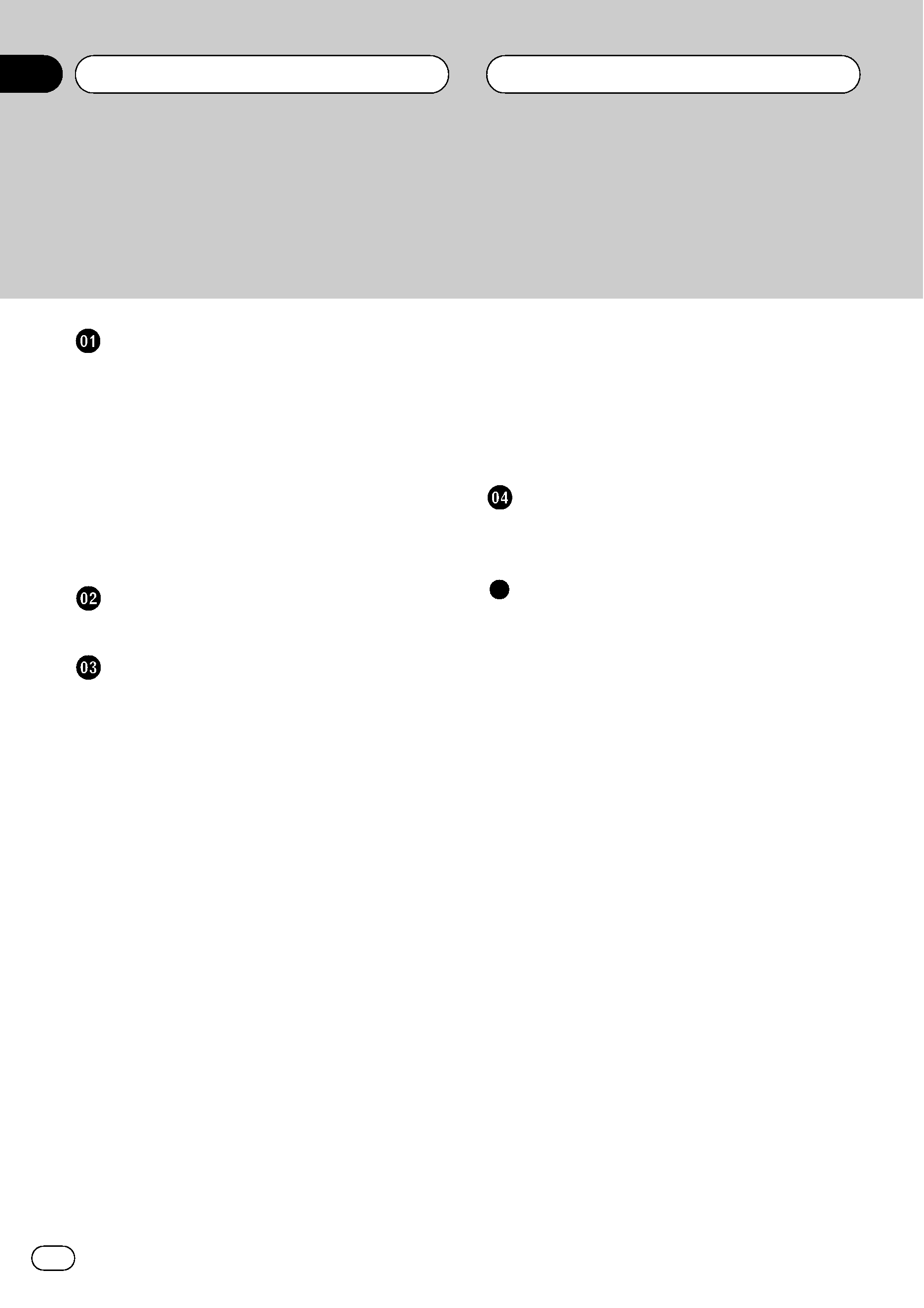
Operation Manual
Mode demploi
Multi-channel AV processor
Processeur AV multi-canaux
DEQ-P8000
English
Français

Thank you for buying this Pioneer product.
Please read through these operating instructions so you will know how to operate
your model properly. After you have finished reading the instructions, keep this man-
ual in a safe place for future reference.
Before You Start
Information to User 4
About this unit 4
About this units optical input 4
Features 4
About this manual 5
After-sales service for Pioneer products 5
Product registration 5
Precautions 6
Resetting the microprocessor 6
Whats What
Head unit 7
Digital Signal Processor
Introduction of DSP adjustments 8
Using the sound field control 8
Using the position selector 9
Using balance adjustment 9
Adjusting source levels 10
Using the dynamic range control 10
Using the down-mix function 10
Using the direct control 11
Using the Dolby Pro Logic B 11
Adjusting the Music mode 11
Setting the speaker setting 12
Correcting the subwoofers phase 12
Selecting a cross-over frequency 13
Adjusting the speaker output levels 13
Adjusting the speaker output levels using a
test tone 14
Using the time alignment 14
Selecting the time alignment
adjustment mode 15
Adjusting the time alignment 15
Using the equalizer 15
Recalling equalizer curves 15
Adjusting 3-band parametric
equalizer 16
Using the auto-equalizer 17
Auto TA and EQ (auto-time alignment and
auto-equalizing) 17
Before operating the auto TA and EQ
function 18
Carrying out auto TA and EQ 18
Initial Settings
Correcting distorted sound 20
Resetting the audio functions 20
Additional Information
Troubleshooting 21
Understanding auto TA and EQ error
messages 22
Terms 23
Specifications 24
Contents
En
2

Selecting fine audio equipment such as the unit you've just purchased is only the start of your
musical enjoyment. Now it's time to consider how you can maximize the fun and excitement your
equipment offers. This manufacturer and the Electronic Industries Association's Consumer
Electronics Group want you to get the most out of your equipment by playing it at a safe level. One
that lets the sound come through loud and clear without annoying blaring or distortion--and, most
importantly, without affecting your sensitive hearing.
Sound can be deceiving. Over time your hearing "comfort level" adapts to higher volumes of
sound. So what sounds "normal" can actually be loud and harmful to your hearing. Guard against
this by setting your equipment at a safe level BEFORE your hearing adapts.
To establish a safe level:
· Start your volume control at a low setting.
· Slowly increase the sound until you can hear it comfortably and clearly, and without distortion.
Once you have established a comfortable sound level:
· Set the dial and leave it there.
Taking a minute to do this now will help to prevent hearing damage or loss in the future. After
all, we want you listening for a lifetime.
We Want You Listening For A Lifetime
Used wisely, your new sound equipment will provide a lifetime of fun and enjoyment. Since
hearing damage from loud noise is often undetectable until it is too late, this manufacturer and the
Electronic Industries Association's Consumer Electronics Group recommend you avoid prolonged
exposure to excessive noise. This list of sound levels is included for your protection.
Decibel
Level
Example
30
Quiet library, soft whispers
40
Living room, refrigerator, bedroom away from traffic
50
Light traffic, normal conversation, quiet office
60
Air conditioner at 20 feet, sewing machine
70
Vacuum cleaner, hair dryer, noisy restaurant
80
Average city traffic, garbage disposals, alarm clock at two feet
THE FOLLOWING NOISES CAN BE DANGEROUS UNDER CONSTANT EXPOSURE
90
Subway, motorcycle, truck traffic, lawn mower
100
Garbage truck, chain saw, pneumatic drill
120
Rock band concert in front of speakers, thunderclap
140
Gunshot blast, jet plane
180
Rocket launching pad
Information courtesy of the Deafness Research Foundation.
En
3
English

Information to User
Alteration or modifications carried out without
appropriate authorization may invalidate the
users right to operate the equipment.
About this unit
Important
! Following functions cannot be operated when
DVH-P7000, DVH-P5000MP or AVH-P6500DVD
is connected to this unit.
Using the down-mix function
Using the Dolby Pro Logic B
Selecting the time alignment adjustment
mode
Using the auto-equalizer
Auto TA and EQ (auto-time alignment and
auto-equalizing)
Resetting the audio functions
! If DVH-P7000, DVH-P5000MP or AVH-
P6500DVD is connected to this unit, operation
of following function is limited.
Selecting a cross-over frequency
About this units optical input
This unit provides two optical inputs, however,
units that can be connected to each input are
limited. Refer to following chart, and use the
optical inputs correctly. Otherwise, this unit
may not operate properly.
Connection with the Pioneer head unit
Optical 1 input
(head unit)
Optical 2 input
(DVD player)
AVH-P6600DVD
AVX-P8DVD
AVX-P7300DVD
SDV-P7
XDV-P90
AVH-P6500DVD
DVH-P5000MP
DVH-P7000
Optical 2 input is not available.
! Only the system with AVH-P6600DVD can
use both optical 1 input and optical 2 input.
Otherwise, optical 2 input is not available.
Connection with the Pioneer audio
master unit
Optical 1 input
(DVD player)
Optical 2 input
(DVD player)
AVX-P8DVD
SDV-P7 *1 *2
XDV-P90 *1 *2
AVX-P7300DVD
SDV-P7 *1 *2
XDV-P90 *1 *2
! For more details concerning connection
with the Pioneer audio master unit, refer to
audio master unit (AXM-P8000) owners
manual.
Features
Dolby Digital/DTS compatibility
When using this unit with a Pioneer DVD
player, you can enjoy the atmosphere and exci-
tement provided by DVD movie and music
software featuring 5.1 channel recordings.
*1 This unit must be set as digital source.
*2 This unit must be set to stand alone mode (master mode).
Before You Start
En
4
Section
01

! Manufactured under license from Dolby La-
boratories. Dolby, Pro Logic, and the
double-Dsymbol are trademarks of Dolby
Laboratories.
! DTS and DTS Digital Surround are regis-
tered trademarks of Digital Theater Sys-
tems, Inc.
About this manual
This unit features a number of sophisticated
functions ensuring superior reception and op-
eration. All the functions have been designed
for the easiest possible use, but many are not
self-explanatory. This operation manual will
help you benefit fully from this units potential
and to maximize your listening enjoyment.
We recommend that you familiarize yourself
with the functions and their operation by read-
ing through the manual before you begin
using this unit. It is especially important that
you read and observe precautions noted on
the next page and in other sections.
After-sales service for
Pioneer products
Please contact the dealer or distributor from
where you purchased this unit for after-sales
service (including warranty conditions) or any
other information. In case the necessary infor-
mation is not available, please contact the
companies listed below:
Please do not ship your unit to the companies
at the addresses listed below for repair without
advance contact.
U.S.A.
Pioneer Electronics (USA) Inc.
CUSTOMER SUPPORT DIVISION
P.O. Box 1760
Long Beach, CA 90801-1760
800-421-1404
CANADA
Pioneer Electronics of Canada, Inc.
CUSTOMER SATISFACTION DEPARTMENT
300 Allstate Parkway
Markham, Ontario L3R OP2
1-877-283-5901
For warranty information please see the Lim-
ited Warranty sheet included with this unit.
Product registration
Visit us at the following site:
1 Register your product. We will keep the details
of your purchase on file to help you refer to
this information in the event of an insurance
claim such as loss or theft.
2 Receive updates on the latest products and
technologies.
3 Download owners manuals, order product
catalogues, research new products, and
much more.
Before You Start
En
5
English
Section
01
